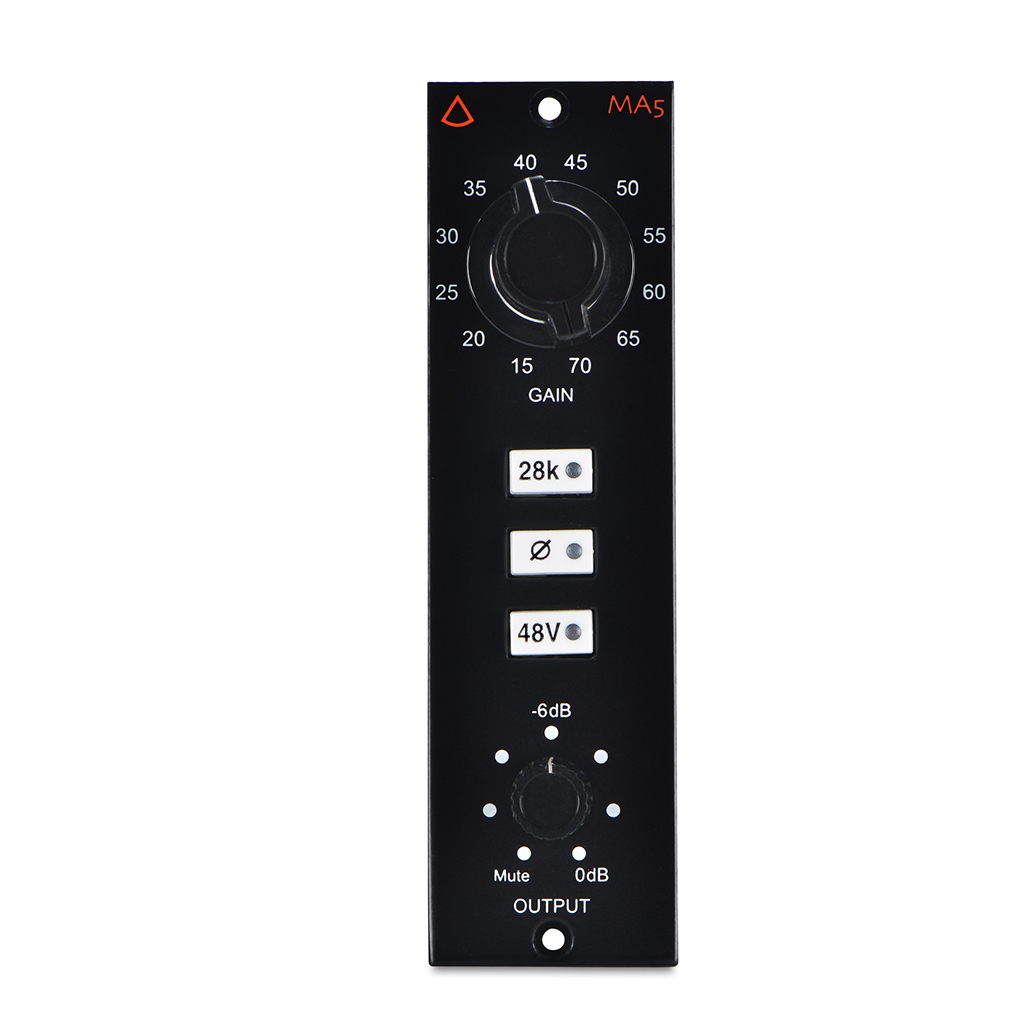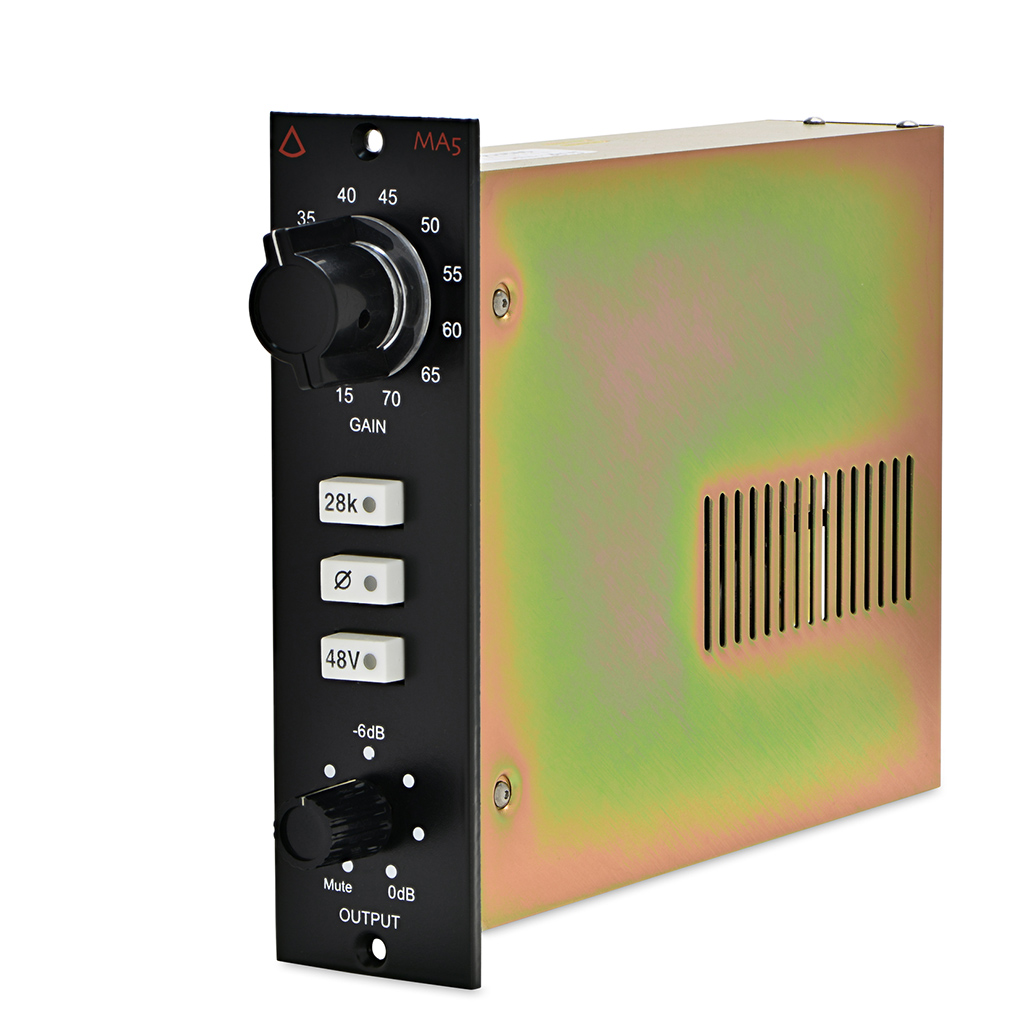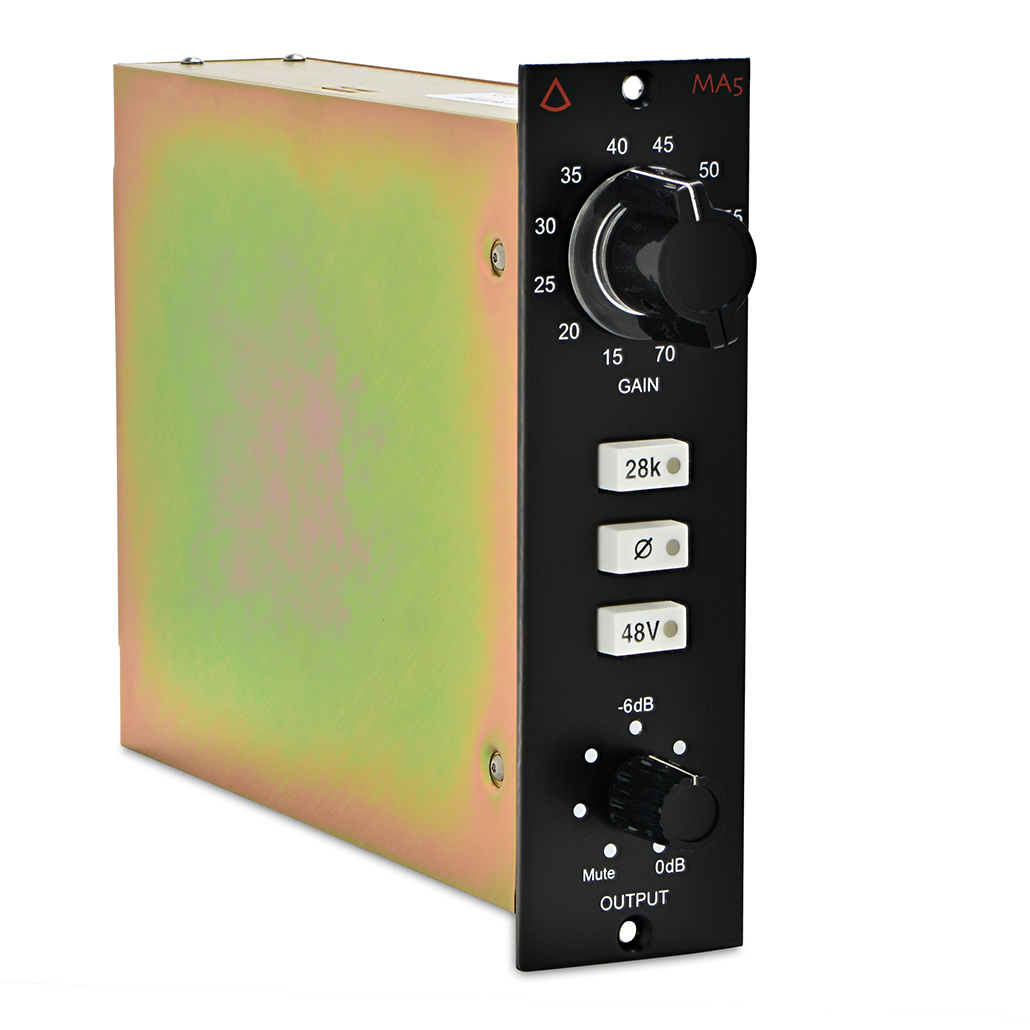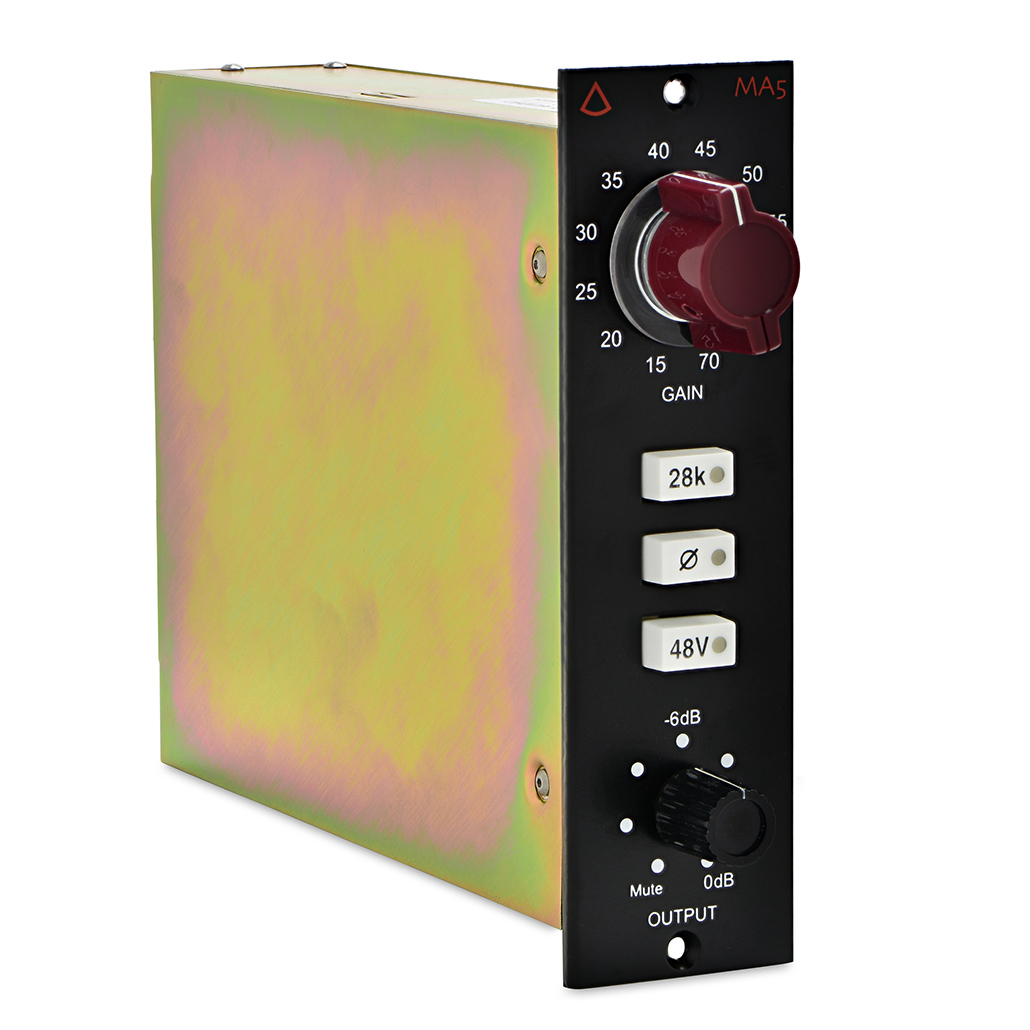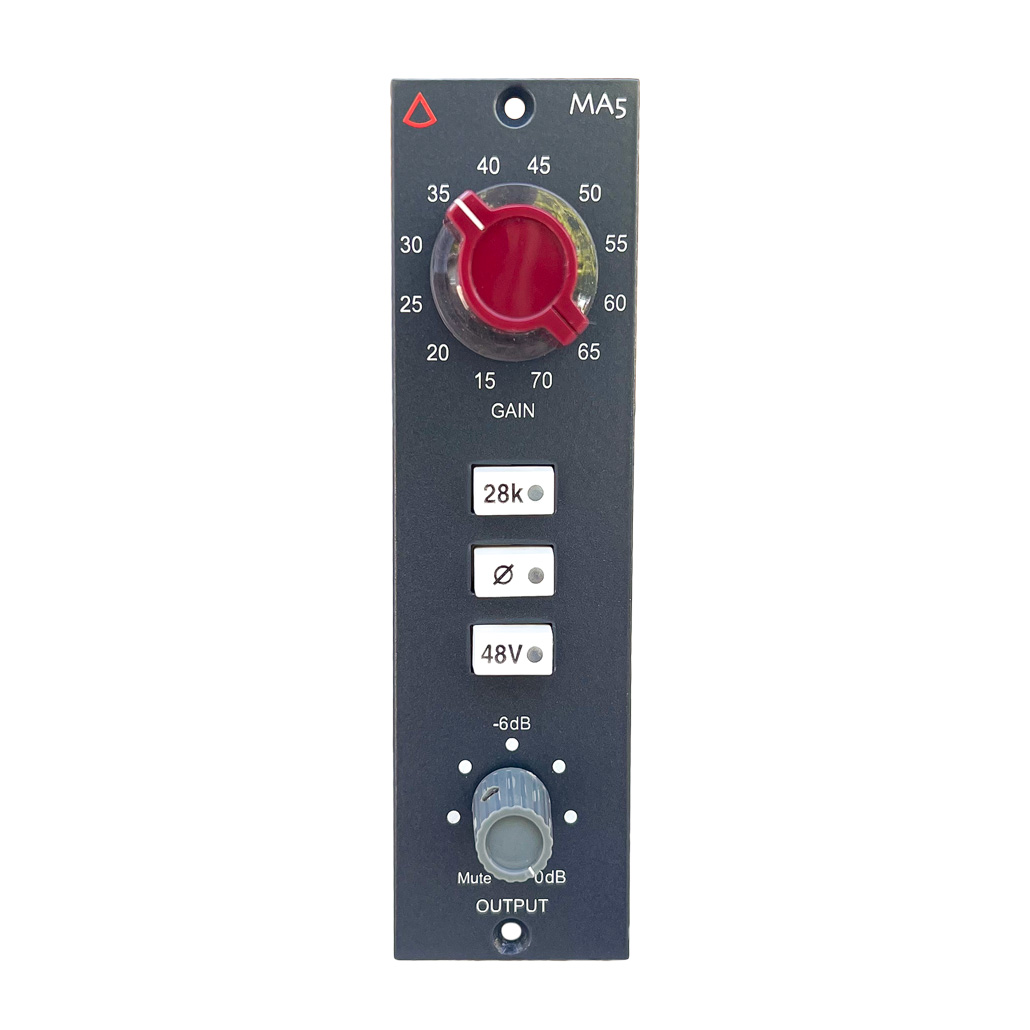MA5
Features
- Standard 500 series modular size 1.5″ x 5.25″
- Direct coupled, single-ended Class A amplifier
- UK-made Carnhill/St Ives input transformer
- In-house specifically made Class A output transformer
- Stepped-gain rotary switch in 5dB steps
- Output level pot for trim and mute
- LED-lit push-buttons
- 28kHz feature brings out high frequency detail
- Custom-made Marconi-style knobs
- High headroom & CMR and low noise design
- Units are thoroughly tested and perfectly matched in level and sound
- 15 years in production
- Time-tested ultra reliable quality circuit design
- Made in California, USA
MA5 Class-A Microphone Preamplifier
The MA5 was created to fill the need for a high-quality microphone preamplifier with the characteristic sound of early ‘70s British Class-A consoles. The re-engineering in the creation of the MA5 stemmed from years of experience restoring both American and British modules, deeply rooted in classic transformer-balanced, discrete electronics. Only the best and most suitable components are used throughout, regardless of cost, to attain the best sound.
The MA5’s full and open sound with harmonic richness, particularly in the very low frequencies- even down to, and below, 10Hz. The clear mids and smooth highs come through without sounding dull or smeared.
Today, after 12 years of production, we are happy to say there are many MA5’s used all over the world, from home studios to large commercial studios, and by other pro-audio professionals everywhere.
FAQ
How can I run LINE level inputs into it from my PT’s or converters?
Because the MA5’s gain is stepped, it makes a very accurate and great-sounding line amplifier to run mixes through. It will add its signature harmonic overtones to the low end. However it is important to optimize the input load and output source impedances.
The LINE PAD-Z is designed for mic pre’s without line inputs, such as the MA5, enabling you to plug a line signal into the mic input.
The LINE PAD-Z adaptor serves three important purposes: 1) It provides the proper load to your PT or other converters without overloading them. 2) It drops the level -35dB, to the range of a microphone. 3) Its output impedance “looks” like a microphone to the MA5 preamp, so source impedances appear normal.
With the use of the LINE PAD-Z on the input of the MA5, unity gain would be at the 35dB position on the gain switch, with the output turned all the way up.
IMPORTANT: When coming out of the preamp into the A/D converter, you must go into the LINE input of your digital converter, not the MIC input which would add gain; otherwise you will have headroom issues and a poor signal-to-noise ratio. Some inputs are both, so you must switch to LINE input or use the TRS part of the combo XLR – read the manual to find out.
The LINE PAD-Z works very well and can be used with other high quality, low noise preamps. Not recommended for unbalanced interfaces.
The LPZ is not specifically a microphone pad, however, it will work and attenuate the same amount. Putting phantom power through the LPZ is not recommended because the resistive network inside the LPZ will only lower the phantom voltage down and not provide enough current to the condenser microphone.
LINE PAD-Z SPECIFICATIONS:
Made with Switchcraft parts
Input impedance = 10K ohms
Attenuation = -36dB
Output impedance = 150 ohms
May be purchased with the MA5 preamplifier, or separately here.
How much current does it draw?
75mA per rail, so 150mA total. This is about double compared to the current draw of the E27 since it is a class A amp with a big output transistor. But unlike class AB units, the current draw stays fairly constant, regardless of level or load to the output.
API 1608 info: It has come to our attention that the MA5’s initial current surge the first second of powering up causes the 1608 power supply to trigger its regulation and turn off. We will work together and hopefully come up with a solution that does not compromise the sound of the MA5, yet meets API’s console requirements. Please contact us with any questions.
ADDITIONAL INFO:
It is equally important to work out how the power supply in a rack or lunchbox responds to the inrush of current to the modules in it. All power supplies we tested have current limiting regulation, meaning that the power supply rail will shut off if it senses a lot of sudden current draw, which can be triggered just by turning the rack/lunchbox on when full of modules.
So, always check to make sure all the lights are lit and everything is working when you first power up. If a rail does not power up, and the power supply had gone into its current limit mode, then turn it off. You will have to find a trim pot on the inside of the power supply which regulates the current limit and turn it up one o’clock at a time and retest each time until the power supply turns on without triggering the limit. Be absolutely sure it’s the current limit adjustment, and not the voltage adjustment, trim pot you are turning. Get a professional’s help to do this, or contact the manufacturer of the rack or lunchbox.
The BAE 11-space Rackmount comes with a large power supply. An example of what the trimpot looks inside is pictured here:
Please contact us if you have any questions and we’ll help you out.
What’s the 28kHz pushbutton for?
This was an idea borrowed from our E27 equalizer, but this time it’s only a 6dB rise and shelving rise at 28kHz. We realized it was so useful for bringing back life and realism to many instruments, we had to put it in the MA5.
It started when we first heard it on live orchestral music recorded by a friend- we could hear the sound stage and its reflections, resulting in a better depth of field. On acoustic guitars, it brought out the upper-end frequency timbre of the instrument. On drums, it sounds particularly nice on the room mic, capturing the natural high-frequency reflections better. Even dynamic microphones can be utilized in certain applications that you wouldn’t have used before.
For vocals, it brought the singer closer without turning up the sibilance frequencies. We thought it might be a good idea to put them on vocals, as many of today’s condenser microphones inherently have a bright top end, but not always in the right place for a particular voice. Adding 28kHz would allow you to use a de-esser or equalizer without losing too much of the top end detail, and without using too much additive eq later. This does depends on the characteristics of the microphone, so be careful not to put the 28kHz on everything!
There’s much more to the applications of the 28kHz feature… just experiment.
What DI do you recommend?
After sound evaluations of 6 different DI units while playing a ’71 Fender Jazz Precision bass and various guitars for this preamp, we found that we liked the Jensen direct box transformer and the Countryman Type 10 or 10S (the older Type 85 is pin 3 hot and would be out-of-phase unless you flip it on the preamp).
The Jensen Transformers DI is called the ISOMAX DB-2PX. It’s actually a great value because it is a 2-CHANNEL unit, and you could also use it in the way the Line Padz works, running a Line level signal throught it as well (-22dbu of level loss so it’s going to be a bit louder than the LPZ) You could have it mounted inside your rack and wire it up to your patchbay.
We sell it for $200 each directly. Contact us with any questions about DI’s.
Why the -6dB marking on the output pot?
It’s a fine trim adjustment to get in between the 5 dB steps of the gain switch. It also mutes when turned down all the way, so you can exchange mics and prevent the speaker thump from phantom power.
No meter?
A meter would be nice for seeing if there is signal present, but considering how high the headroom is on this preamp (+31dBu into 10kohms, +27dBu into 600 ohms) the meter you should be looking at is the one for your recorder, like an A/D converter, which will clip at a lower level.
I’ve seen these with a Red gain knob. Can I get it that way?
Yes, just let your dealer know you want a red knob. Recently, we’ve taken photographs of it (as of June 28, 2019)
I see the MA5 in both red or a black faceplates. Is there any difference between the two?
There are no differences between faceplate or knob colors and it is purely cosmetic.
The first group of MA5’s had red faceplates due to a few dealer’s suggestions. We had always preffered a blackface (with the red highlights on the logo and name) so had them made but never showed it until a client asked if black was available, and it was. It has been the default color now.
There was also a grayish-green color made for another dealer, which was a color matched from some old test equipment we had.
When installing them in my API rack, they’re a little tight due to the two screws at the top and bottom. What to do?
Place the lower part of the MA5 in first with the screws just inside, then just pull on the top slightly to get the top screws in. The lip on the API lunchbox or rack is bent a little too far in on some units, and using countersunk flathead screws on the MA5 means using weaker screws that can strip easily, instead of the stainless steel that used now. The original dimensions of the MA5 is correct.
Can I purchase output transformers from you for a DIY?
Sorry, no. The output transformer is custom-made for us through a research and design collaboration between Avedis Audio and Jensen Transformers, in a proprietary agreement. As of July 2023, Avedis Transformers will be making the output transformer to the exact same specifications on a highly modified transformer winding machine which took over a year to customize.
Seconds after powering down, it is normal to still hear a loud signal?
Yes, it’s the capacitors discharging but keeping the power up for a little while. This is normal for this particular type of Class A amp. It is recommended to mute your monitors or disconnect the preamps from your speakers or headphones when you power down.
Why do I hear a buzz/hum with the MA5 preamp but not with other pre’s I also have in the same rack?
The rack itself may have a grounding issue, either as a Pin 1 problem, a common (zero) not connected to chassis, safety ground not connected (unsafe and illegal), or some combination including all three.
The noise is really on all the preamps, but it will be more noticeable with the MA5 because the Class A amplifiers run with more gain than most other 500 series preamps, which have less gain from the op-amp but more step-up gain from the input transformer. Any noise that gets into the audio ground will be heard proportional to the gain, (for example, via building ground/conduit to pin 1).
Contact us if you’re having a problem with the rack; we will need to run tests and document any problems before having it fixed.
UPDATE: Please DO NOT use the MA5 or the E27 with an OSA rack. The problems with regulator inconsistencies causing high ripple noise, miswiring of the rack, and even safety is a risk to our modules.
2/19/10 – Please be careful not to pull on the output pot to remove the MA5 from the rack. This will damage the output pot and create a dead spot.

